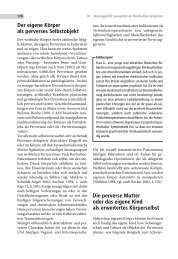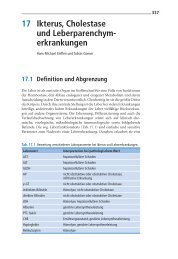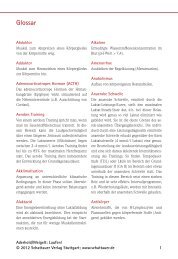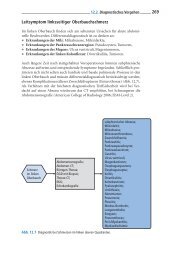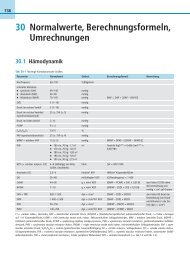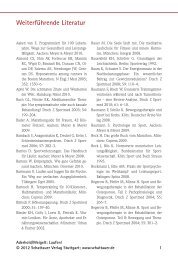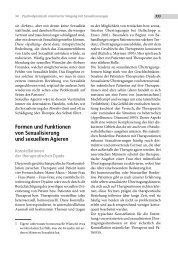DVO Guideline 2009 for Prevention, Diagnosis and Therapy of ...
DVO Guideline 2009 for Prevention, Diagnosis and Therapy of ...
DVO Guideline 2009 for Prevention, Diagnosis and Therapy of ...
You also want an ePaper? Increase the reach of your titles
YUMPU automatically turns print PDFs into web optimized ePapers that Google loves.
64 <strong>DVO</strong> <strong>Guideline</strong> Osteoporosis <strong>2009</strong><br />
If necessary, an extended geriatric assessment<br />
should follow.<br />
9.2 Bone Mineral Density Measurement<br />
(Osteodensitometry)<br />
9.2.1 Tasks <strong>of</strong> Bone Mineral Density<br />
Measurement<br />
The tasks <strong>of</strong> bone mineral density<br />
measurement are:<br />
1. To assess whether osteoporosis is present<br />
according to the operational definition<br />
<strong>of</strong> the WHO (T-score ≤–2.5) <strong>and</strong> to<br />
assess whether the criteria <strong>for</strong> a proved<br />
efficacy <strong>of</strong> specific osteoporotic drug<br />
treatment (T-score grade 2 according to Kellgren,<br />
significant scolioses <strong>and</strong> torsion scolioses<br />
as well as atherosclerosis.<br />
At the proximal femoral neck the<br />
T-score <strong>of</strong> the total hip <strong>and</strong> the T-score <strong>of</strong><br />
the femoral neck are best suited <strong>for</strong> risk assessment<br />
<strong>and</strong> the assessment <strong>of</strong> therapeutic<br />
efficiency (A–D). For the diagnostic assessment<br />
<strong>of</strong> osteoporosis, bone mineral density<br />
measurement <strong>of</strong> one hip is sufficient. If<br />
measurement results <strong>of</strong> both sides are<br />
available, the average value <strong>of</strong> the left <strong>and</strong><br />
right total hip <strong>and</strong> the femoral necks, respectively,<br />
are to be used <strong>for</strong> treatment recommendations<br />
(E 117).<br />
For the assessment <strong>of</strong> the 10-year fracture<br />
risk the lowest T-score <strong>of</strong> the DXA<br />
measurement at the lumbar spine, the total<br />
hip <strong>and</strong> the femoral neck is applied here.<br />
For the fracture risk calculation the hip<br />
T-scores <strong>of</strong> the NHANES data base were<br />
taken as a reference. For the lumbar spine<br />
the T-scores <strong>of</strong> the DXA manufacturing<br />
companies were taken as references. Other<br />
methods, st<strong>and</strong>ard values, measuring areas<br />
or procedures <strong>for</strong> determining bone density<br />
can at best only partly be applied to the<br />
following risk assessment.<br />
9.2.3 Recommending Treatment<br />
without prior Measurement<br />
An intertrochanteric femoral fracture or<br />
the finding <strong>of</strong> two or more typical vertebral<br />
osteoporotic fractures on X-ray justifies<br />
starting drug treatment even without prior<br />
DXA measurement (D) (E118). If the total<br />
clinical situation is appropriate (B), a bone<br />
density measurement can be omitted in<br />
order to prevent a fracture in the case <strong>of</strong> a<br />
high clinical risk. This applies <strong>for</strong> example<br />
to multi morbid older osteoporosis patients<br />
with a very high risk <strong>of</strong> subsequent<br />
fractures but limited access to diagnostic<br />
evaluation, who otherwise would be left<br />
untreated (E119). Furthermore, there are<br />
an increased number <strong>of</strong> constellations,<br />
such as the combination <strong>of</strong> double-sided<br />
hip replacement <strong>and</strong> osteoporotic fractures<br />
at the lumbar spine, <strong>for</strong> which assessment<br />
<strong>of</strong> bone density is not possible despite typical<br />
osteoporotic fractures. In such cases it is<br />
to be assumed that bone density measurement<br />
would give erroneously low results<br />
<strong>and</strong> that treatment efficiency is a given (B).<br />
However, even in the case <strong>of</strong> typical vertebral<br />
fractures, a DXA measurement is recommended<br />
be<strong>for</strong>e starting treatment <strong>of</strong> patients<br />
<strong>for</strong> whom bone mineral density<br />
measurements are easily per<strong>for</strong>med (D).<br />
The reason <strong>for</strong> this is that a normal bone<br />
mineral density in a patient, despite prevalent<br />
fractures, should always lead to differential<br />
diagnostic considerations <strong>for</strong> assessing<br />
other reasons <strong>for</strong> the fractures. A normal<br />
bone mineral density, despite fractures, also<br />
poses some questions with regard to the efficacy<br />
<strong>of</strong> the pharmacological treatment, <strong>and</strong><br />
thus has to be decided <strong>for</strong> the individual<br />
case, preferably with the aid <strong>of</strong> an expert.<br />
9.2.4 Alternative Procedures<br />
Quantitative ultrasound measurements<br />
(A–D depending on method) <strong>and</strong> peripheral<br />
bone mineral density measurement<br />
apart from central DXA measurements at<br />
the lumbar spine <strong>and</strong> the hip (A–D depending<br />
on method) can also provide in<strong>for</strong>mation<br />
about the fracture risk<br />
(E120, E122). While a bone density<br />
measurement by DXA provides in<strong>for</strong>mation<br />
both with regard to absolute fracture<br />
risk <strong>and</strong> treatment efficacy, the latter has<br />
not been analysed using ultrasound. There<strong>for</strong>e,<br />
be<strong>for</strong>e starting osteoporosis treatment<br />
a measurement <strong>of</strong> bone mineral density by<br />
DXA cannot at present be replaced by<br />
ultrasound measurements with the exception<br />
<strong>of</strong> a substantially increased fracture<br />
risk (E123). To avoid an unnecessary<br />
double diagnostic assessment the <strong>DVO</strong><br />
there<strong>for</strong>e, as a rule, recommends the DXA<br />
measurement (D).<br />
An initial diagnostic assessment by<br />
quantitative ultrasound may be useful<br />
under the following exceptional circumstances<br />
(D):<br />
1. as part <strong>of</strong> the initial risk assessment <strong>for</strong><br />
patients at high risk <strong>for</strong> whom carrying<br />
out a DXA is difficult or<br />
2. as part <strong>of</strong> the risk assessment <strong>for</strong> high<br />
risk patients with a typical vertebral<br />
Osteologie 1/2011 © Schattauer 2011




